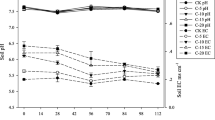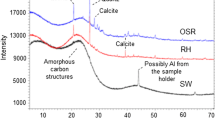Abstract
Purpose
This study compares the dynamic effects of straw and biochar on soil acidity and phosphorus (P) availability in the rice growth period to reveal how straw and biochar affect the availability of phosphorus in soil and utilization of P for rice crop.
Materials and methods
In the pot experiment, rice straw, canola stalk, and corresponding biochars were mixed uniformly with the Ultisol. Soil samples were collected at four stages of rice growth to analyze the dynamic changes of soil acidity and P availability. The availability of phosphate in straw/biochar-amended soils were evaluated using a combination of chemical extraction and diffusive gradients in thin films (DGT) technique.
Results
Soil pH, KCl-P, Olsen-P, DGT-P, and Al-P deceased with the rice growth, while Fe-P increased. Biochar increased soil pH and P availability more than straw returning, especially in the mature stage, while the DGT-P only increased in the tillering stage. The DGT-induced fluxes in sediments (DIFS) model revealed that all treatments increased the capacity of soil solid phase supplementing P to pore water in the filling and mature stages. The content of total P in different rice tissues followed the order of grain > straw > root, and RB350 treatment had the highest P content in rice tissues. In the mature stage, soil pH had positive correlations with KCl-P and Olsen-P, and soil Fe-P had positive correlations with total P of root and straw.
Conclusions
Application of biochar made at 550 ℃ resulted in a larger increase in available P in soil, while biochar made at 350 ℃ had more effect on the chemical forms of P. The canola stalk biochar showed a larger influence on the P availability than rice straw biochar. Biochar treatments had a larger effect on inhibiting soil acidification and improving P availability than straw returning directly.






Similar content being viewed by others
References
Bao SD (2000) Soil and agricultural chemistry analysis. Chinese Agriculture Press, Beijing
Bornø ML, Müller-Stöver DS, Liu F (2018) Contrasting effects of biochar on phosphorus dynamics and bioavailability in different soil types. Sci Total Environ 627:963–974. https://doi.org/10.1016/j.scitotenv.2018.01.283
Cai Z, Wang B, Xu M, Zhang H, Zhang L, Gao S (2014) Nitrification and acidification from urea application in red soil (Ferralic Cambisol) after different long-term fertilization treatments. J Soils Sediments 14(9):1526–1536. https://doi.org/10.1007/s11368-014-0906-4
Chen M, Alim N, Zhang Y, Xu N, Cao X (2018) Contrasting effects of biochar nanoparticles on the retention and transport of phosphorus in acidic and alkaline soils. Environ Pollut 239:562–570. https://doi.org/10.1016/j.envpol.2018.04.050
Ding S, Chen M, Cui J, Wang D, Lin J, Zhang C, Tsang DC (2018) Reactivation of phosphorus in sediments after calcium-rich mineral capping: implication for revising the laboratory testing scheme for immobilization efficiency. Chem Eng J 331:720–728. https://doi.org/10.1016/j.cej.2017.09.010
Ding S, Jia F, Xu D, Sun Q, Zhang L, Fan C, Zhang C (2011) High-resolution, two-dimensional measurement of dissolved reactive phosphorus in sediments using the diffusive gradients in thin films technique in combination with a routine procedure. Environ Sci Technol 45(22):9680–9686. https://doi.org/10.1021/es202785p
Eduah JO, Nartey EK, Abekoe MK, Breuning-Madsen H, Andersen MN (2019) Phosphorus retention and availability in three contrasting soils amended with rice husk and corn cob biochar at varying pyrolysis temperatures. Geoderma 341:10–17. https://doi.org/10.1016/j.geoderma.2019.01.016
Farrell M, Macdonald LM, Butler G, Chirino-Valle I, Condron LM (2014) Biochar and fertiliser applications influence phosphorus fractionation and wheat yield. Biol Fertil Soils 50(1):169–178. https://doi.org/10.1007/s00374-013-0845-z
Filippelli GM (2008) The global phosphorus cycle: past, present, and future. Elements 4(2):89–95. https://doi.org/10.2113/GSELEMENTS.4.2.89
Gao S, DeLuca TH (2018) Wood biochar impacts soil phosphorus dynamics and microbial communities in organically-managed croplands. Soil Biol Biochem 126:144–150. https://doi.org/10.1016/j.soilbio.2018.09.002
Gao S, DeLuca TH, Cleveland CC (2019) Biochar additions alter phosphorus and nitrogen availability in agricultural ecosystems: a meta-analysis. Sci Total Environ 654:463–472. https://doi.org/10.1016/j.scitotenv.2018.11.124
Gilbert N (2009) Environment: the disappearing nutrient. Nature News 461(7265):716–718. https://doi.org/10.1038/461716a
Gu Y, Hou Y, Huang D, Hao Z, Wang X, Wei Z, Jousset A, Tan S, Xu D, Shen Q, Xu Y, Xu Y (2017) Application of biochar reduces Ralstonia solanacearum infection via effects on pathogen chemotaxis, swarming motility, and root exudate adsorption. Plant Soil 415(1–2):269–281. https://doi.org/10.1007/s11104-016-3159-8
Gul S, Whalen JK (2016) Biochemical cycling of nitrogen and phosphorus in biochar-amended soils. Soil Biol Biochem 103:1–15. https://doi.org/10.1016/j.soilbio.2016.08.001
Guo JH, Liu XJ, Zhang Y, Shen JL, Han WX, Zhang WF, Christie P, Goulding K, Vitousek P, Zhang FS (2010) Significant acidification in major Chinese croplands. Science 327(5968):1008–1010. https://doi.org/10.1126/science.1182570
Harper MP, Davison W, Tych W (2000) DIFS—a modelling and simulation tool for DGT induced trace metal remobilisation in sediments and soils. Environ Model Softw 15(1):55–66. https://doi.org/10.1016/S1364-8152(99)00027-4
Hass A, Gonzalez JM, Lima IM, Godwin HW, Halvorson JJ, Boyer DG (2012) Chicken manure biochar as liming and nutrient source for acid Appalachian soil. J Environ Qual 41(4):1096–1106. https://doi.org/10.2134/jeq2011.0124
Hedley MJ, Stewart JWB, Chauhan B (1982) Changes in inorganic and organic soil phosphorus fractions induced by cultivation practices and by laboratory incubations. Soil Sci Soc Am J 46(5):970–976. https://doi.org/10.2136/sssaj1982.03615995004600050017x
Hong C, Lu S (2018) Does biochar affect the availability and chemical fractionation of phosphate in soils? Environ Sci Pollut Res 25(9):8725–8734. https://doi.org/10.1007/s11356-018-1219-8
Hong C, Su Y, Lu S (2018) Phosphorus availability changes in acidic soils amended with biochar, fly ash, and lime determined by diffusive gradients in thin films (DGT) technique. Environ Sci Pollut Res 25(30):30547–30556. https://doi.org/10.1007/s11356-018-3086-8
Horst WJ, Kamh M, Jibrin JM, Chude VO (2001) Agronomic measures for increasing P availability to crops. Plant Soil 237(2):211–223. https://doi.org/10.1023/A:1013353610570
Laird DA, Fleming P, Davis DD, Horton R, Wang B, Karlen DL (2010) Impact of biochar amendments on the quality of a typical Midwestern agricultural soil. Geoderma 158(3–4):443–449. https://doi.org/10.1016/j.geoderma.2010.05.013
Long H, Li X, Wang H, Jia J (2013) Biomass resources and their bioenergy potential estimation: a review. Renew Sustain Energy Rev 26:344–352. https://doi.org/10.1016/j.rser.2013.05.035
Madiba OF, Solaiman ZM, Carson JK, Murphy DV (2016) Biochar increases availability and uptake of phosphorus to wheat under leaching conditions. Biol Fertil Soils 52(4):439–446. https://doi.org/10.1007/s00374-016-1099-3
Manolikaki II, Mangolis A, Diamadopoulos E (2016) The impact of biochars prepared from agricultural residues on phosphorus release and availability in two fertile soils. J Environ Manag 181:536–543. https://doi.org/10.1016/j.jenvman.2016.07.012
Menezes-Blackburn D, Zhang H, Stutter M, Giles CD, Darch T, George TS, Shand C, Lumsdon D, Blankwell M, Wearing C, Cooper P, Wendler R, Brown L, Haygarth PM (2016) A holistic approach to understanding the desorption of phosphorus in soils. Environ Sci Technol 50(7):3371–3381. https://doi.org/10.1021/acs.est.5b05395
Murphy JAMES, Riley JP (1962) A modified single solution method for the determination of phosphate in natural waters. Anal Chim Acta 27:31–36. https://doi.org/10.1016/S0003-2670(00)88444-5
Parvage MM, Ulén B, Eriksson J, Strock J, Kirchmann H (2013) Phosphorus availability in soils amended with wheat residue char. Biol Fertil Soils 49(2):245–250. https://doi.org/10.1007/s00374-012-0746-6
Pheav S, Bell RW, Kirk GJD, White PF (2005) Phosphorus cycling in rainfed lowland rice ecosystems on sandy soils. Plant Soil 269(1–2):89–98. https://doi.org/10.1007/s11104-004-0396-z
Rose TJ, Schefe C, Weng ZH, Rose MT, van Zwieten L, Liu L, Rose AL (2019) Phosphorus speciation and bioavailability in diverse biochars. Plant Soil 443(1–2):233–244. https://doi.org/10.1007/s11104-019-04219-2
Schoumans OF, Bouraoui F, Kabbe C, Oenema O, van Dijk KC (2015) Phosphorus management in Europe in a changing world. Ambio 44(2):180–192. https://doi.org/10.1007/s13280-014-0613-9
Shen Q, Hedley M, Camps Arbestain M, Kirschbaum MUF (2016) Can biochar increase the bioavailability of phosphorus? J Soil Sci Plant Nutr 16(2):268–286. https://doi.org/10.4067/S0718-95162016005000022
Soil Survey Staff (2014) Keys to soil taxonomy, 12th edn. USDA-Natural Resources Conservation Service, Washington DC
Soinne H, Hovi J, Tammeorg P, Turtola E (2014) Effect of biochar on phosphorus sorption and clay soil aggregate stability. Geoderma 219:162–167. https://doi.org/10.1016/j.geoderma.2013.12.022
Song D, Tang J, Xi X, Zhang S, Liang G, Zhou W, Wang X (2018) Responses of soil nutrients and microbial activities to additions of maize straw biochar and chemical fertilization in a calcareous soil. Eur J Soil Biol 84:1–10. https://doi.org/10.1016/j.ejsobi.2017.11.003
Ulrich A, Boersma M, Sargison J, Adams P, Singh B, Franks S, Birch CJ, Close DC (2018) Nutrient changes in potting mix and Eucalyptus nitens leaf tissue under macadamia biochar amendments. J For Res 29(2):383–393. https://doi.org/10.1007/s11676-017-0437-0
Ulrich B (1986) Natural and anthropogenic components of soil acidification. Zeitschrift Für Pflanzenernährung Und Bodenkunde 149(6):702–717. https://doi.org/10.1002/jpln.19861490607
Venturini G, Pizarro-Alonso A, Münster M (2019) How to maximise the value of residual biomass resources: the case of straw in Denmark. Appl Energy 250:369–388. https://doi.org/10.1016/j.apenergy.2019.04.166
Wang T, Camps-Arbestain M, Hedley M (2014) The fate of phosphorus of ash-rich biochars in a soil-plant system. Plant Soil 375(1–2):61–74. https://doi.org/10.1007/s11104-013-1938-z
Wrobel-Tobiszewska A, Boersma M, Sargison J, Adams P, Singh B, Franks S, Birch CJ, Close DC (2018) Nutrient changes in potting mix and Eucalyptus nitens leaf tissue under macadamia biochar amendments. J For Res 29(2):383–393. https://doi.org/10.1007/s11676-017-0437-0
Xu G, Sun J, Shao H, Chang SX (2014) Biochar had effects on phosphorus sorption and desorption in three soils with differing acidity. Ecol Eng 62:54–60. https://doi.org/10.1016/j.ecoleng.2013.10.027
Xu G, Zhang Y, Sun J, Shao H (2016a) Negative interactive effects between biochar and phosphorus fertilization on phosphorus availability and plant yield in saline sodic soil. Sci Total Environ 568:910–915. https://doi.org/10.1016/j.scitotenv.2016.06.079
Xu N, Tan G, Wang H, Gai X (2016b) Effect of biochar additions to soil on nitrogen leaching, microbial biomass and bacterial community structure. Eur J Soil Biol 74:1–8. https://doi.org/10.1016/j.ejsobi.2016.02.004
Yang C, Lu S (2021) Pyrolysis temperature affects phosphorus availability of rice straw and canola stalk biochars and biochar-amended soils. J Soils Sediments 0:1–14. https://doi.org/10.1007/s11368-021-02993-0
Yang C, Lu S (2022) Straw and straw biochar differently affect phosphorus availability, enzyme activity and microbial functional genes in an Ultisol. Sci Total Environ 805:150325. https://doi.org/10.1016/j.scitotenv.2021.150325
Yuan JH, Xu RK (2012) Effects of biochars generated from crop residues on chemical properties of acid soils from tropical and subtropical China. Soil Research 50(7):570–578. https://doi.org/10.1071/SR12118
Yuan JH, Xu RK, Qian W, Wang RH (2011) Comparison of the ameliorating effects on an acidic Ultisol between four crop straws and their biochars. J Soils Sediments 11(5):741–750. https://doi.org/10.1007/s11368-011-0365-0
Zhang H, Davison W, Gadi R, Kobayashi T (1998) In situ measurement of dissolved phosphorus in natural waters using DGT. Anal Chim Acta 370(1):29–38. https://doi.org/10.1016/S0003-2670(98)00250-5
Zhou C, Heal K, Tigabu M, Xia L, Hu H, Yin D, Ma X (2020) Biochar addition to forest plantation soil enhances phosphorus availability and soil bacterial community diversity. For Ecol Manag 455:117635. https://doi.org/10.1016/j.foreco.2019.117635
Zwetsloot MJ, Lehmann J, Bauerle T, Vanek S, Hestrin R, Nigussie A (2016) Phosphorus availability from bone char in a P-fixing soil influenced by root-mycorrhizae-biochar interactions. Plant Soil 408(1–2):95–105. https://doi.org/10.1007/s11104-016-2905-2
Funding
This research was supported by the Key Research & Development Program of Zhejiang Province (2022C02018) and the National Natural Science Foundation of China (41977005).
Author information
Authors and Affiliations
Contributions
Caidi Yang: investigation, methodology, data curation, writing — original draft. Shenggao Lu: conceptualization, project administration, supervision, funding acquisition, writing — review and editing.
Corresponding author
Ethics declarations
Conflict of interest
The authors declare no competing interests.
Additional information
Responsible editor: Xiaoqi Zhou
Publisher's note
Springer Nature remains neutral with regard to jurisdictional claims in published maps and institutional affiliations.
Highlight
• Soil pH and available P (KCl-P and Olsen-P) decreased with the rice growth.
• The Al-P content decreased with the rice growth, while the Fe-P increased.
• Biochar improved soil acidification and availability of P more than straw returning.
• The parameters (R, k1, k-1 and Tc) obtained by DIFS model explained the increased P availability.
• The biochar made at 350 ℃ increased the total P in the straw and grain of rice significantly.
Supplementary information
Below is the link to the electronic supplementary material.
Rights and permissions
About this article
Cite this article
Yang, C., Lu, S. The dynamic changes of phosphorus availability in straw/biochar-amended soils during the rice growth revealed by a combination of chemical extraction and DGT technique. J Soils Sediments 22, 957–967 (2022). https://doi.org/10.1007/s11368-021-03131-6
Received:
Accepted:
Published:
Issue Date:
DOI: https://doi.org/10.1007/s11368-021-03131-6




